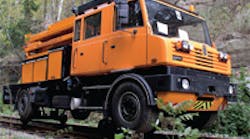Self-contained Welderliner rail maintenance vehicle is as at home riding the rails as it is driving on roads. Hydraulics powers its rail drive and auxiliary functions.
The most practical method of rail maintenance is to use a self-contained vehicle that actually rides the rails. However, these vehicles are relatively slow moving, so having them spend a lot of time on a rail line could delay rail traffic. An alternative to a self-contained rail vehicle is one that can ride the rails or drive on surface roadways. Such is the case with the DAF 8×2 XF 95 Welderliner, designed and built by SaZ sro, Szava, Czech Republic. The Welderliner can travel the right-of-ways alongside a rail line, then deploy a hydraulic drive that places it on the track, at which time a hydrostatic drive provides propulsion for the vehicle.
The Welderliner is equipped with a full workshop to carry out resistance spot welding, making it ideal for urgent track repairs. Almost 11 m long and weighing nearly 32 tons, it is one of SaZ’s biggest track vehicles. The vehicle can be placed onto the tracks, where it uses resistance spot welding equipment to repair long sections of track when required, no matter how remote the location.
Making the switch
The Welderliner has two undercarriage hydrostatic drives mounted behind its road axles in order to change from road machine to track machine. These under carriage drives can move sideways, making it possible to place the vehicle anywhere on the tracks. A Bosch Rexroth series A4VG axial-piston pump powers each set of rail wheels, which are driven by Rexroth A2FM fixed-displacement motors. Speed of the motors is controlled by Rexroth DA valves, which can produce creep speeds down to 2 km/hr. This walking speed is ideal for track welding and for auxiliary functions, such as cutting back growth on embankments. Electrohydraulic proportional valves built directly onto the pump regulate fluid flow to make the drive energy efficient.
Various auxiliary functions of the road-rail vehicle — such as placing itself on the tracks, braking, and providing the suspension for it — are supplied by Rexroth gear pumps. Each hydraulic system is built from standard components, which keeps costs down by limiting inventory and the number of vendors.
For more information on Bosch Rexroth mobile hydraulic components and systems, visit www.boschrexroth-us.com.


